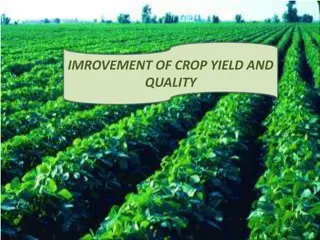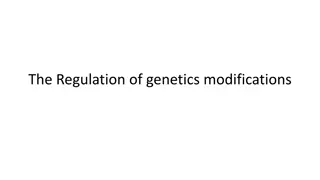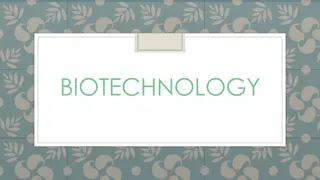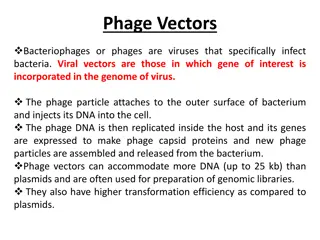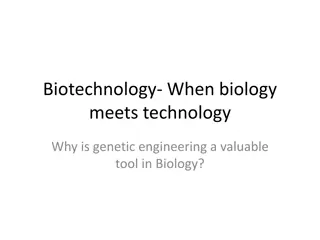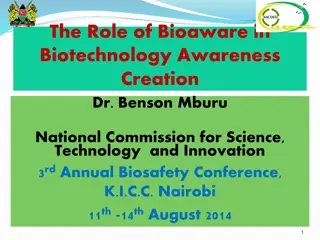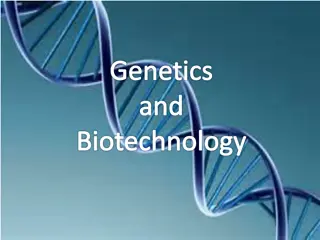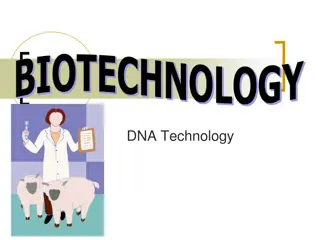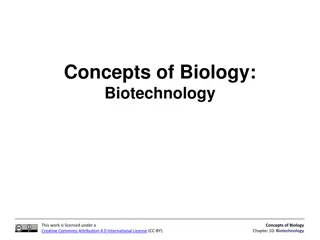Genetic Manipulation in Environmental Biotechnology
Genetic manipulation strategies in environmental biotechnology involve techniques like gene splicing and molecular cloning to modify genes directly. These methods have various applications such as isolating genes, producing specific molecules, improving biochemical production, creating organisms with desirable traits, and more. Steps in genetic engineering include gene isolation, vector insertion, organism modification, cell transformation, and GMO selection. Recombinant organisms like bacteria, yeast, viruses, and transgenic plants are produced through genetic manipulation. Biotransformation of pollutants using microbial processes is a sustainable approach for environmental cleanup. Recent methodological breakthroughs have provided insights into how microorganisms adapt and biodegrade pollutants efficiently.
Download Presentation

Please find below an Image/Link to download the presentation.
The content on the website is provided AS IS for your information and personal use only. It may not be sold, licensed, or shared on other websites without obtaining consent from the author. Download presentation by click this link. If you encounter any issues during the download, it is possible that the publisher has removed the file from their server.
E N D
Presentation Transcript
GENETIC MANIPULATION STRATEGIES IN ENVIRONMENTAL BIOTECHNOLOGY
GENETIC MANIPULATION Genetic technology, (GM) and gene splicing are the terms that apply to the direct manipulation of an organism s genes. GE uses the techniques of molecular cloning and transformation to alter characteristics of genes directly. GE aims at isolating DNA fragments and recombining them. engineering, genetic recombinant manipulation/modification DNA the structure and
CURRENT INTEREST IN GE IS DUE TO ITS VARIED APPLICATIONS. 1. Isolation of a particular gene, gene part or region of a genome. 2. Production of a particular molecules in quantities. 3. Improvement in the production of biochemicals and commercially important organic chemicals. 4. Production of varieties of plants having particular desirable characteristics. 5. Correction of genetic defects in higher organisms 6. Creation of organisms with economically important features. RNA and protein
STEPS IN GE Five major steps are involved during GE process: Isolation of the gene of interest. Insertion of the gene into a vector. Transfer of the vector to the organism to be modified. Transformation of the cells of the organism. Selection of the GMO from those that have not been successfully modified. 1. 2. 3. 4. 5.
RECOMBINANTS Recombinant Bacteria Recombinant Yeast Recombinant Viruses Transgenic Plants
Biotransformation of various pollutants is a sustainable way to environments. These bioremediation methods harness the microbial catabolic transform or accumulate compounds including hydrocarbons (e.g. oil, polychlorinated biphenyls (PCBs), polyaromatic hydrocarbons(PAHs), pharmaceutical substances, and metals. clean up contaminated biotransformation naturally diversity to a huge and occurring, degrade, range of
Major methodological breakthroughs in recent years have enabled metagenomic, proteomic, bioinformatic and other high-throughput analyses relevant microorganisms providing unprecedented insights into biotransformation biodegradative pathways organisms to adapt to changing environmental conditions. are producing vast amounts of information. Biological processes play a major role in the removal of contaminants and pollutants from the environment. Some microorganisms possess an astonishing catabolic versatility to degrade or transform such compounds. detailed genomic, of environmentally and and the ability of
RELEASE OF GENETICALLY MANIPULATED ORGANISMS INTO THE ENVIRONMENT In microorganisms molecular biologists believed that the process was unsafe and that manipulated microorganisms should be strictly contained and prevented from release environment. The fundamental fear was, and with many still is, that genetically engineered microorganisms could escape from the laboratory into unpredictable and perhaps catastrophic consequences. It was believed that such released microorganisms could upset the balance of nature or that foreign DNA in the new microorganism could alter its metabolic activity in unpredictable and undesirable ways. the 1970s, when GE being experiments developed, with many were first to the the environment with
In response to these concerns, guidelines were established to ensure safe working practices and levels of containment based on potential hazards. However, with time awareness, many of these regulations have been progressively relaxed with systems. Many important medical products, such as insulin and human growth hormone and some industrial enzymes, are manufactured containment fermentation processes that involve specific genetically manipulated microorganisms. and increased technical recognised low-risk in large-scale
the manipulated organism was not subject to release and remained within the manufacturing site to be correctly disposed of. However, recombinant microorganisms are now being considered for deliberate release into the environment where they cannot be contained, e.g. biological control, inoculants in agriculture, live vaccines, bioremediation, baker s and brewer s yeast. In addition, we are now witnessing the moving out, in increasing numbers, of recombinant plants from research laboratories greenhouses and test-plots greenhouses of the farmer and large commercial horticulture grower. and the containment fields to the and
Recombinant extensively used to improve specific characteristics of plants used for commercial food production. Most of these crops consequently must be grown on a large scale in the open environment to achieve commercial success. The development of transgenic crop varieties is routinely monitored over 2 5 years of field trials to evaluate the performance of the new plants under field conditions. The tasks are normally conducted under strict conditions that prevent the movement of plants and pollen from the test sites. DNA technology is now being
GENETIC MODIfiCATION AND FOOD USES The application of genetic engineering to food production is intended to enhance the useful and desirable characteristics of the organisms and to eliminate the undesirable. Genetic engineering is increasingly being applied to many breeding programmes to achieve the same aims as the traditional methods, but offering two main advantages: (1) the introduction of genes can be controlled with greater prediction and precision than by previous methods. (2) the introduction of genes into unrelated species is not possible using traditional methods.
The overall aim of the food industry, with respect to genetic engineering, will be: to improve the quantity and increase the quality and properties of existing food productions, to produce new products. Several examples like the amylose-free potato and the indigo-producing bacterium also involve the use of organisms genetically modified by recombinant DNA technology.
Many benefits that genetic engineering might give the producer, including: disease and pest resistance, weed control, animal growth hormones, improved food microorganisms, novel products, Improved keeping quality Improved products qualities. In contrast, some would consider that there are many potential risks associated with these new approaches, including: unintentional transfer of genes in to other crops, creations of herbicide-resistant weeds, increased monoculture, the undermining of traditional economies. Some believe that it is a technology out of control.
While the public have readily accepted medical products produced from organisms (GMOs). The safety of the human food supply is based on the concept that there should be a reasonable certainty that no harm will result from its consumption. Foods or food ingredients derived from GMOs must be considered to be safe. In many countries there government-supported committees to check on the safety of GMOs in food production, which examine the technical details for their use or their products. genetically modified are now specialist
An early UK report (by the Committee on the Ethics of Genetic Modification and Food Use, 1993) identified some of the main ethical concerns relating to the food use of certain transgenic organisms: (1) Transfer of human genes to food animals (e.g. transfer of human gene, a protein involved in blood clotting, into sheep; (2) Transfer of genes from animals whose flesh is forbidden for use as food by certain religious groups into animals which they normally eat (e.g. pig genes into sheep would offend Muslims); (3) Transfer of animal genes into food plants which may be of particular concern to some vegetarians (especially vegans); (4) Use of organisms containing human genes as animal feed(e.g. yeast modified to produce human proteins of pharmaceutical value and the spent yeast then used as animal feed).
A recent US Institute of Food Technologists concluded that use of rDNA biotechnology provide a number of important benefits to society: a more abundant and economical food supply for the world; continued improvements in nutritional quality, including foods of unique composition for populations whose diets lack essential nutrients; fresh fruit and vegetables with improved shelf life; the development of functional foods, vaccines and similar products, which may provide health and medical benefits; Further improvements in production agriculture through more efficient production practices and increased yields; the conversion of non-productive toxic soils, in developing countries, to productive arable land; More environmentally friendly agricultural practices through improved pesticides and pesticide-usage practices, less hazardous animal wastes and improved utilization of land
CONCLUSION New rDNA-biotechnology-derived foods and food products do not inherently present any more serious environmental concerns or unintended toxic properties than those already presented by conventional breeding practices. Appropriate testing by technology developers, producers and processors, regulatory agencies and others should be continued for new foods and food products derived from all technologies, including rDNA biotechnology. Programmes should be developed to provide the benefits of safe and economical rDNA-biotechnology-derived food products worldwide, including less-developed countries.








